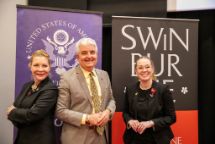Australia’s moon rover takes off with Swinburne University of Technology developing critical technology for success

Swinburne University of Technology has been selected as a research university that will deliver key technology for Australia’s first lunar rover.
In summary
- Swinburne University of Technology has been selected as a research university that will deliver key technology Australia’s first lunar rover.
- The $42 million Australian Space Agency project will see the ELO2 consortium design, construct, and operate the Australian-made rover on the moon.
- Swinburne’s Space Technology and Industry Institute will provide lunar dust mitigation and space radiation technology for the rover.
Swinburne University of Technology has been selected as a research university that will deliver key technology for a history-making national project: Australia’s first lunar rover.
The $42 million Australian Space Agency project will see the ELO2 consortium design, construct, and operate the Australian-made rover, "Roo-ver," on the lunar surface.
Swinburne’s Space Technology and Industry Institute (STII) will be providing space radiation and lunar dust mitigation technology for the rover, essential for the success of the project in the harsh lunar environment.
STII Co-Director Dr Rebecca Allen says the project solidifies Australia even further as a space-faring nation.
“We’re focusing on critical technology to support the rover’s performance—evaluating and testing how the Moon’s hazardous radiation and harsh environment will affect its capabilities.”
“This includes advancing active dust mitigation, as well as tackling the challenges of lunar conditions, zero gravity and radiation simulations. It’s vital work, with Swinburne playing a key role in coordinating and validating Australia’s space qualifications."
One of the biggest challenges of lunar operations is managing moon dust. Far more than a mere inconvenience, this fine, sharp and abrasive powder blankets the Moon’s surface and can travel vast distances – potentially hundreds of metres or even kilometres in zero gravity. With particles as sharp as shards of glass, lunar dust can clog and jam critical mechanisms such as equipment conveyors, lock buttons, cameras, and even vacuum systems.
"Swinburne University of Technology is delighted to be a partner that will bring this Australian space first to life,” says Deputy Vice-Chancellor, Research Professor Karen Hapgood.
“Having our Space Technology and Industry Institute providing lunar dust and space radiation technology for the rover cements our global reputation as a leader in space science, astrophysics, robotics, engineering and instrumentation, and the depth of Australia's space capabilities, which are often underestimated."
Space technology made in Australia
The ELO2 Consortium is an unparalleled collaboration of industry organisations and leading research organisations from across Australia focused on space exploration. This partnership will deliver a rover that is fully designed, manufactured and tested in Australia—demonstrating the country’s technical leadership and engineering prowess.
“This incredible initiative demonstrates that Australia has the capability to build rovers and play an important role in humanity’s return to the Moon. Most importantly, this gives our staff and students the opportunity to be at the forefront of lunar science and innovation.”
-
Media Enquiries
Related articles
-

- Astronomy
- Technology
- Science
Swinburne’s Spotlight on STEM: A Night of Space Innovation with Shelli Brunswick
Swinburne University hosted a Spotlight on STEM event with space innovator Shelli Brunswick, exploring space technology, leadership, and career opportunities in the space industry
Friday 21 March 2025 -

- Technology
- Education
- Science
- University
New Australia-India joint research institute to advance energy, communications, materials and manufacturing technologies
Swinburne University of Technology and the Indian Institute of Technology Hyderabad (IITH) have launched the Swinburne-IITH Manufacturing, Materials, Energy and Communication Technologies (SIMMECT) Joint Research Institute, to drive impactful research and global collaboration on major technology challenges.
Monday 03 March 2025 -

- Health
- Science
Swinburne to boost AI-driven design for dental devices with investment in H3D
Swinburne has invested in spinout company H3D, a cutting-edge tech company that is reinventing custom-fit devices using AI and automation.
Monday 31 March 2025 -

- Science
- Sustainability
Swinburne joins global Green Steel Alliance to advance carbon-neutral ironmaking and steelmaking
Swinburne has become a founding member of the global Green Steel Alliance. The Green Steel Alliance brings together leading research and industry stakeholders from around the world to advance the transition to a green economy.
Wednesday 12 March 2025 -

- University
- Astronomy
- Science
‘Big Wheel’ disk galaxy discovered accidentally by international team
An international team involving Swinburne University of Technology has discovered a giant spiral disk galaxy in the early cosmos.
Tuesday 18 March 2025

